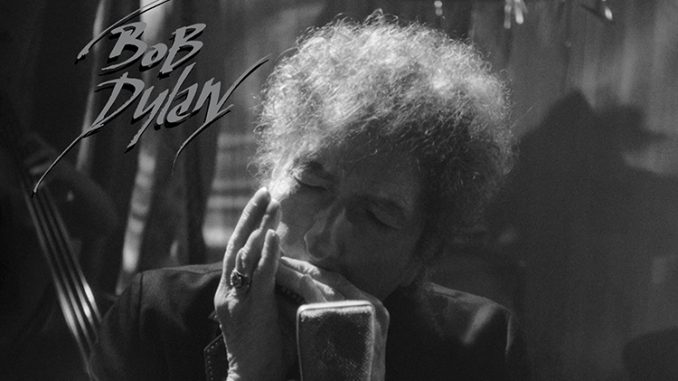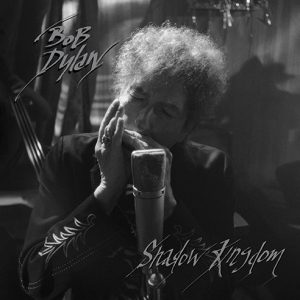
Take Two: Bob Dylan Brings Some of His Classics Into the Now!
On Shadow Kingdom, Dylan sings “When I Paint My Masterpiece,” “Queen Jane Approximately,” “Watching the River Flow” and ten others.
By Michael Goldberg.
Bob Dylan lives in the present, and he doesn’t want to repeat himself. According to guitarist Ira Ingber, one of the musicians who have worked with Dylan and played on Dylan’s Shadow Kingdom, “Bob is the most in the moment person I’ve met in my life. It’s only about right now. … Whatever this moment is that we’re in, that’s what becomes recorded.”
And being in the moment during the recording of Shadow Kingdom has given the classic old songs it contains new life. (I should add that a video version of Shadow Kingdom that makes it appear that Dylan is performing the songs live in a hip club is available, but it’s actually all lip-synched. It looks cool but I’m focusing on the album in this essay.)
At first when I listened to Shadow Kingdom, I thought there were songs (like “When I Paint My Masterpiece”) that really worked with their new arrangements, and others (“I’ll Be Your Baby Tonight”) that didn’t. But as I’ve played the album over and over, I’ve come to the conclusion that the entire album is quite wonderful – the new arrangements work throughout – some revised songs just take longer to get used to than others. They’re all good.
 On Shadow Kingdom, recorded at Village Recorder in West Los Angeles in early 2021, the playing by the musicians who accompanied Dylan (I’ll list them shortly) is subtle, nuanced and, to my ear, beautiful, brilliant, and quite distinctive. The sound these musicians delivered on Shadow Kingdom is, in a way, brand new.
On Shadow Kingdom, recorded at Village Recorder in West Los Angeles in early 2021, the playing by the musicians who accompanied Dylan (I’ll list them shortly) is subtle, nuanced and, to my ear, beautiful, brilliant, and quite distinctive. The sound these musicians delivered on Shadow Kingdom is, in a way, brand new.
It’s a kind of folk-rock, but a very low-keyed, mostly acoustic folk-rock that has nothing to do with the Byrds or Dylan’s electric mid-’60s recordings. No drums. No piano or organ. Just guitars (both acoustic and electric), bass (upright and electric), accordion, harmonica, pedal steel guitar and mandolin. Although no musician other than Dylan himself is named on the album, the musicians playing include Jeff Taylor and Doug Lacy on accordion, Tim Pierce, T-Bone Burnett, Ira Ingber, and Steve Bartek on guitar, Don Was and John Avila on bass, Greg Leisz on guitar, pedal steel and mandolin and Dylan on guitar, harmonica and, of course, vocals. It reminds me a little of early Fairport Convention (“I’ll Keep It With Mine”), but different.
Dylan sings in great voice; as throughout his three Sinatra albums and Rough and Rowdy Ways, his vocals are by turns, casual, dramatic and sincere – and very mature. Because his singing is so good, and because of the fresh arrangements and sound, this stands out as one of Dylan’s best albums in years (the other being Rough and Rowdy Ways).
Dylan’s selection of songs – drawn from Bob Dylan’s Greatest Hits Volume II, Blonde on Blonde, Highway 61 Revisited, John Wesley Harding, Nashville Skyline, Oh Mercy, Planet Waves, and Bringing It All Back Home plus a new one, an instrumental titled “Sierra’s Theme” – is inspired.
He opens with “When I Paint My Masterpiece,” a gleaming gem of a song we first heard performed by The Band on Cahoots two months before Dylan’s version was released on Bob Dylan’s Greatest Hits Volume II. I used to think when listening to the Volume II version of the song, that when he sang, “Someday everything’s gonna be different/ When I paint that masterpiece,” that he was stating a fact: he was going to eventually paint his masterpiece and when he did, everything would be different in a positive way. We just had to wait for the inevitable.
But listening to a 79 year old (at time of the recording) Bob Dylan sing those lines, I now hear something different. He’s saying, if only I could paint my masterpiece, things would be different, but that will never happen. It’s like when people say, if only I was rich or if only I was famous. There but for fortune…
By opening the album with this song, Dylan is saying to us: This is the life we have, make the most of it, don’t waste your time waiting for some lucky break that will change everything. You could live your whole life waiting.
It Blew My Young Mind
I was 12 years old the first time I heard Bob Dylan. The song, played on a Top 40 station in July of 1965, was “Like a Rolling Stone” and it blew my young mind. It was the greatest thing I’d ever experienced. I had to have the song on record so I could listen again and again and not have to wait by the radio until it was eventually replayed.
I walked to the record store about a mile from my house and tried to find an album with “Like a Rolling Stone” on it, but Highway 61 Revisited was actually still being recorded. So I bought the single, and then before too long I bought the next single, “Positively 4th Street,” only the copy I got contained an outtake of “Can You Please Crawl Out Your Window” in place of “Positively 4th Street” (I still have that single). Eventually I also got a copy with “Positively 4th Street” on it. All three songs are, of course, tremendous, and I became a serious Bob Dylan fan.
As I’ve written before, hearing “Like a Rolling Stone” had a profound impact on me. It certainly motivated me to challenge the status quo, and to live my life on my terms. It inspired me. It gave me the strength to go my own way. I decided I was going to be a music journalist, a risky profession, which barely existed in the late ’60s. I wasn’t sure if I’d become a writer or a photographer – I pursued both for a while – but I was going to spending my life doing things that mattered to me, and not (despite my mother and father’s wishes) waste my time on getting a degree in something that would bring me money but which my heart wasn’t in. “You can’t make a living writing about rock & roll, my dad insisted. I didn’t care, though it turned out he was very wrong.”
Making The Old Songs New Again
Most of the songs here are classics, and hearing them now, especially the songs released that summer of 1965 when I first heard “Like a Rolling Stone,” bring back the feelings I felt as a teenager first discovering Dylan. I remember sitting on the couch in our living room reading Wilkie Collins “The Moonstone” while Highway 61 Revisited played over and over. One of the songs that really moved me at the time was “Queen Jane Approximately.” The third song on Shadow Kingdom is “Queen Jane Approximately,” with its memorable melody still intact.
Dylan describes Queen Jane’s superficial life and implores her to dispense with the bullshit and to come see him. I’ve always thought of “Queen Jane Approximately” as a love song, but Dylan could also, especially by reprising the song on his latest album, be sending all of us a message, asking us to see through the material madness of life in the 21st century and seek out a way of living that is authentic and true.
To include both “I’ll Be Your Baby Tonight” and “To Be Alone With You,” love songs that appeared on John Wesley Harding and Nashville Skyline, respectively, Dylan is emphasizing, as he sang on another Nashville Skyline song, “I Threw It All Away” (not included here) that, “Love is all there is, it makes the world go ’round/ Love and only love, it can’t be denied.” Dylan is long known for raising the bar for songwriting, dealing with subjects that had not previously been addressed in rock songs. But with the inclusion of these two songs, he’s making it clear that to dismiss love songs as silly and superficial is a mistake.
Shadow Kingdom also includes two particularly intense songs – “Just Like Tom Thumb’s Blues” and “Tombstone Blues” – from Highway 61 Revisited. The first finds the narrator depressed and alone in Juárez, suffering “hungry women” who “really make a mess out of you” and hard drugs. He’s so fucked up he doesn’t even “have the strength to take another shot.” The second is, in part, an anti-war (the Vietnam war was going on at the time) song. Both seem timely given the hard drug plague we’re in the midst of, and the ongoing Russia-Ukraine war (as well as a war of sorts between Democrats and Republicans). It’s interesting too that Dylan recites, rather than sings, “Tombstone Blues.”
Dylan sings “Forever Young,” an interesting choice that perhaps alludes to his songs remaining relevant even as many decades pass from when they were written, and the initially unappreciated “Watching the River Flow,” which some people thought was about Dylan no longer having anything to say, but according to Greil Marcus was Dylan trying to come to terms with his success while maintaining a connection to his fans. Listening to the song now, it’s hard to overlook the line, “People disagreeing everywhere you look.” Perhaps “To sit down on this bank of sand/ And watch the river flow” might be the best thing to do right now, to rise above the current madness.
There’s a lot more here, but I’m not going to detail every song. While Dylan ends the album with an instrumental, the beautiful “Sierra’s Theme,” the final song with lyrics, also recited, is “It’s All Over Now, Baby Blue” (off Bringing It All Back Home), famously aimed at the folkies who rejected his full-blown turn to rock & roll in 1965 and still relevant as Dylan continues to make new music on his own terms.
Writer and photographer Michael Goldberg has been interviewing and photographing musicians since he was 17. He was a senior writer at Rolling Stone magazine for a decade. In May 2022 his book, Wicked Game: The True Story of Guitarist James Calvin Wilsey was published. Addicted To Noise: The Music Writings of Michael Goldberg was published on November 1, 2022.

